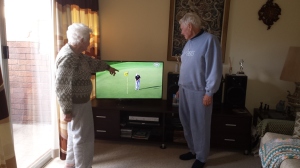My house is quite small, considering five people and a cat live in it. We have three bedrooms, one bathroom and a space which serves as kitchen, dining room and living room. Yet in this tiny space there are four televisions- one in each bedroom and a big one in the living room. My house is hardly unique however- most homes these days have multiple televisions because they are almost considered as basic a necessity as a toilet. This was not always the case though.
My grandparents (who I call Ibu and Bapak) got their first television in 1961 when my mother was less than a year old. It was an extremely expensive black-and-white box with rabbit ears which received 4 channels. The reception wasn’t great, it was prone to interference and the picture would roll. Despite this my grandparents loved it. In fact prior to buying their own, they would go over to a friend’s house every Friday night and watch their TV. Because television was such an alien thing in those days, Ibu recalls feeling physically exhausted on Saturday morning.
Although all the photos we see of families watching early TVs depict the viewers sitting very close to the screen, my grandparents remember sitting as far away from it as possible, and my mother and uncle were encouraged to do the same. They also always had a light on while the TV was on and Bapak remembers needing to purchase a television licence for 25 pounds a year.
In the early days of television in Australia, my mum says, TV was more about entertainment.
“The shows that were on didn’t try to make you think about or reflect on life- they were just light entertainment.”
The biggest shows on TV were late-night comedy shows equivalent to Jay Leno now, things like The Graham Kennedy Show and Hey Hey It’s Saturday. It wasn’t until the 1970s that this changed, during the latter period of the Vietnam War. Suddenly real life and true horror was being experienced in people’s homes. The huge reaction to these horrific images indirectly ended the War, and showed TV show producers that people responded to real-life. This, my mum theorises, is why television shows such as M*A*S*H were such a huge success.
My grandparents eventually upgraded to a colour television in 1976, just in time for the Olympics, because they love their sport. Recently they bought a new flat-screen so they can watch all their sport in high definition.


